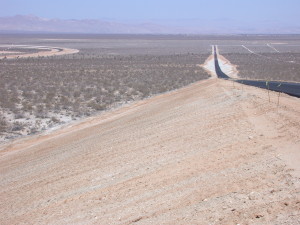02 Nov 2014
Revegetation Opportunities During Drought
Drought: an extended period when a region receives a deficiency in its water supply, whether atmospheric, surface or ground water.
Drought as an Educator:
NASA scientists are advising that an unusual atmospheric phenomenon is occurring in which a high-pressure ridge over the western part of the U.S. essentially deflects storms northward.* Changes in temperature in the Pacific Ocean might be responsible for the high-pressure ridge. The same type of ridge was present during the 1934 drought (the worst North American drought year of the last millennium) and others, such as the one in California in 1976.
One feature of the 1934 drought that wasn’t expected this time is the severe dust storms. In the 1930s many farmers cleared native vegetation to plant crops that were not drought tolerant, leading to widespread erosion when the crops failed for lack of water. It was believed that better farming methods and wiser choice of crops would prevent those storms from happening again.
Yet dust storms are exactly what are being experienced up in the Antelope Valley farming district. The solar and wind power projects being built there are drawing the ire of local residents, but the abandonment of active farming of crops is equally to blame. Land that was converted from pristine desert to exotic grasses pasture 60 years or more ago is slowly but surely returning to a state of bare ground vulnerable to windblown sand. The current drought is again driving home the lessons learned in 1934.
As far as reclamation technologies are concerned, if plentiful rainfall works to mask many of the shortcomings of conventional seeding practices, drought serves to expose such shortcomings. Drought triggers a more acute understanding of the relative limitations of the spectrum of erosion control products at our disposal, and may spur us into broadening our education about Best Management Practices (“BMP”); for example, by attending our Western Chapter “Soil and Vegetation Management in Response to Drought”workshop on November 5 in Rancho Cordova (website link).
Take for example our industry’s Bonded Fiber Matrix (“BFM”) hydroseeding BMP. A revegetation innovation by Weyerhaeuser 15 or so years ago, Soilguard was a technological leap forward over our industry standard “2,000 lb. wood fiber mulch + 16-20-0 + light-duty tackifier”seeding BMP.
Tellingly, the innovation was developed at Weyerhaeuser’s headquarters west of the Cascade Mountain Range where 80 inches of annual rainfall is common. Soilguard ran into its first limitation as a universally-appropriate revegetation BMP when it was applied in arid desert conditions east of its moisture-rich Puget Sound birthplace. In regions where sparse rainfall or drought is the norm (i.e. much of the western U.S.), the BMP came up short as a comprehensive revegetation seeding solution.
The BFM still functions admirably as an immediate, though temporary, stabilizer of disturbed soils, and remains a vital component in ushering in new plant growth in temperate climates on soils that, despite topical disturbance, remain relatively fertile. But a BFM alone (or any of the topical mulch surface treatments) is not capable of revitalizing a drastically disturbed soil into a functioning soil community, capable of nurturing native plant growth on a sustainable basis.
In fact, in arid regions, a typical BFM load of wood/paper mulch is counter-productive to revegetation objectives. Where lack of moisture in the soil is the prime limiting factor to plant survival, the last result we wish to invite is to have whatever traces of precipitation are received be intercepted at the soil surface where it is quickly evaporated away by hot desert breeze and sun. Rather, precious moisture must infiltrate down into the soil where the roots of germinating seed can reach it.
Drought as Inspiration
Drought inspires us to sharpen our revegetation technologies to attain success where conventional seeding practices are prone to failure. Shift the focus from immediate and temporary soil stabilization alone, and move towards setting the stage for re-establishing a functioning soil community that can support sustainable plant growth in these harsh conditions. The re-establishment of plant growth has always been the gold standard for long-term erosion control.
 We’ve all heard how rugged native plant species are, oftentimes with the attendant cautionary advice that such native plant species are nonetheless difficult-to-impossible to grow from seed. The presumption is that native plants should be germinated and nurtured in the nursery, and then planted out as a seedling. However, anyone who spent time reviewing the data contained in the 2010 Revegetation Guidance Document for Erosion Control Projects in the Tahoe Basin prepared for the California Tahoe Conservancy by AECOM would be inclined to reject this planting protocol, based upon the low survival rate of such plants over the long term, at least in the harsh Tahoe Basin. If not from seed, and not from live plantings, how does the revegetation professional successfully restore plant growth in harsh and drought environments?
We’ve all heard how rugged native plant species are, oftentimes with the attendant cautionary advice that such native plant species are nonetheless difficult-to-impossible to grow from seed. The presumption is that native plants should be germinated and nurtured in the nursery, and then planted out as a seedling. However, anyone who spent time reviewing the data contained in the 2010 Revegetation Guidance Document for Erosion Control Projects in the Tahoe Basin prepared for the California Tahoe Conservancy by AECOM would be inclined to reject this planting protocol, based upon the low survival rate of such plants over the long term, at least in the harsh Tahoe Basin. If not from seed, and not from live plantings, how does the revegetation professional successfully restore plant growth in harsh and drought environments?
Start with the soil. This realization is critical. While average or abundant rainfall can mask soil deficiencies, drought exposes them, and inspires erosion control practitioners to seek long term solutions in the soil.
Drought and Soil Vitality:
Practitioners who are consistently successful at re-establishing native plant growth on sterile, drastically disturbed soils pursue both seeding and planting strategies. They implement these dual revegetation BMPs with an eye to re-establishing a functioning soil community in the upper levels of their seedbed soil.
First, minimize the disturbance that is caused to the soil in your project. In reclamation, there is much truth to the adage “You don’t know the value of what you’ve got, until you lose it”.
Second, obtain an understanding of the true plant growth challenges in the site-specific soils that confront you. Cookie-cutter seeding amendment recipes that pay scant attention to soil conditions are prone to failure. A comprehensive soil analysis and an expert interpretation of that soil analysis, is in order.
Third, many challenging soil situations share similar deficiencies that, in varying degrees, require attention:
- A requirement to re-build stable soil humus in the soil, a critical component of a soil’s organic matter;
- A requirement to insert minerals to address whatever mineral imbalances exist in the soil;
- A requirement to take advantage of soil biostimulants to biologically improve soil structure, moisture and nutrient availability to the plant, and assist in the development and establishment of mycorrhizal fungal colonization.
Learn more about establishing erosion control and vegetation in drought conditions. There are plenty of opportunities to put our expertise to work during a drought. We look forward to seeing you in Rancho Cordova, CA on November 5.
* October 18, 2014, Geophysical Research Letters
24 Sep 2014
S.O.S – 250 Facebook Votes to Save Our Soil
Please vote for Quattro Environmental, Inc. at www.missionmainstreetgrants.com/business/detail/17089.
Quattro has the technologies to mitigate one of the greatest threats to our society: ecological suicide via erosion, soil salinization, and soil fertility losses. What Quattro lacks is the manpower to get the word out. Winning the Mission Main Street Grant would help us “blanket the earth” with our technologies.
Eighteen years ago I was at an International Erosion Control Association conference when a startling consensus was announced: The low bid mandate for awarding state agency native plant seeding contracts was the most expensive route to implementing a revegetation project!
Fast forward to 2014, there have been no significant changes made to our dysfunctional government policies, and taxpayer funds continue to be squandered on revegetation efforts that have little chance of being successful. Until now.
In what Peter Thiel might call a “vertical progress” idea, Quattro announced their Certified Reclamation Team in May 2014, designed to overcome the tried-and-failed design and implementation shortcomings of State and Federal agency reclamation efforts. Now we can provide government agencies the same enhanced reclamation success as is enjoyed by private sector companies such as Shell Oil, Hyundai Motor Corporation, Rio Tinto Minerals, Central AZ Project and others. An outline of the program can be viewed at https://www.quattroenvironmental.com/2014/05/
When we are successful at accumulating 250 votes for Quattro’s application for a Mission Main Street Grant, we become eligible for a $150,000 grant to more effectively tell our Quattro “Living Soil Membrane” technology story. Your vote in favor of Quattro Environmental, Inc. would be appreciated in making this a reality.
Note: You must have a Facebook account to place your vote at the URL listed above. Alternatively, you can:
- Go to www.missionmainstreetgrants.com
- Search for Quattro Environmental, Inc.
- Click the VOTE NOW button next to the business name.
Thanks.





